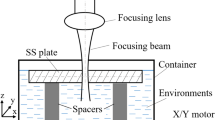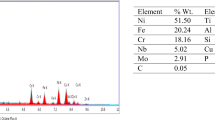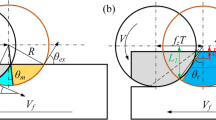Abstract
Based on the experimental results, this study develops a multi-objective optimization scheme to obtain the set of optimal process parameters for pulsed laser direct cutting of non-oriented silicon steel sheets for manufacturing motor core laminations. The experiments were conducted in the nital solvent, which was the one with the smallest thermal effect of laser cutting among the candidate environments of air, deionized water, alcohol, lubricant oil, sodium chloride solution, and nital solution. The laser was a pulsed Nd:YAG nanosecond laser and the thickness of the silicon steel was 100 μm. The effects of three laser process parameters, laser power (P), cutting speed (v), and pulse repetition rate (f) on the cutting qualities of the heat-affected zone (HAZ), cutting time (TC), and multiple dimensional accuracies of the cut core lamination were examined. The inspected geometric accuracies included the errors in inner and outer core diameters (ED1 and ED2), the error in tooth width (EL), and the roundness of inner and outer diameters (C1 and C2). The developed multi-objective optimization model was a PSI-based ELM-GA scheme consisting of the extreme learning machine (ELM) model for connecting the inputs and the outputs, the preference selection index (PSI) method for obtaining the weighted multi-objective function, and the genetic algorithm (GA) for process optimization. Through employing the predicted optimal process parameter set, the validation experiment showed that the errors between the prediction and the experimental result for the seven qualities of HAZ, ED1, ED2, C1, C2, EL, and TC were 4.04%, 6.25%, 4.02%, 0.48%, 2.14%, 5.09%, and 1.25%, respectively. The HAZ and geometric accuracy of the cut core laminations were qualified for the subsequent lamination assembly. Consequently, the merit of direct formation of ready-for-assembly core laminations without the need for any post-processing renders the proposed laser cutting scheme an economical and effective approach for manufacturing motor core laminations from thin silicon steel sheets.














Similar content being viewed by others
Data availability
The data and material are available.
Code availability
Not applicable for this section.
Abbreviations
- SS:
-
Silicon steel
- TSSS:
-
Thin silicon steel sheet
- HAZ:
-
Heat-affected zone
- AI:
-
Artificial intelligence
- MRA:
-
Multiple regression analysis
- ANN:
-
Artificial neural network
- ELM:
-
Extreme learning machine
- GA:
-
Genetic algorithm
- E D1 :
-
Error of inner diameter
- E D2 :
-
Error of outer diameter
- E L :
-
Error of tooth width
- C 1 :
-
Roundness of inner diameter
- C 2 :
-
Roundness of outer diameter
- T C :
-
Cutting time
References
Schoppa A, Schneider J, Roth J-O (2000) Influence of the cutting process on the magnetic properties of non-oriented electrical steels. J Magn Mag Mater 215–216:100–103. https://doi.org/10.1016/S0304-8853(00)00077-9
Belhadj A, Baudouin P, Breaban F, Deffontaine A, Dewulf M, Houbaert Y (2003) Effect of laser cutting on microstructure and on magnetic properties of grain non-oriented electrical steels. J Magn Mag Mater 256:20–31. https://doi.org/10.1016/S0304-8853(01)00937-4
Emura M, Landgraf FJG, Ross W, Barreta JR (2003) The influence of cutting technique on the magnetic properties of electrical steels. J Magn Mag Mater 254–255:358–360. https://doi.org/10.1016/S0304-8853(02)00856-9
Loisos G, Moses AJ (2005) Effect of mechanical and Nd:YAG laser cutting on magnetic flux distribution near the cut edge of non-oriented steels. J Mater Process Technol 161:151–155. https://doi.org/10.1016/j.jmatprotec.2004.07.061
Siebert R, Schneider J, Beyer E (2014) Laser cutting and mechanical cutting of electrical steels and its effect on the magnetic properties. IEEE Trans Magn 50. https://doi.org/10.1109/TMAG.2013.2285256
Belhadj A, Baudomin P, Houbaert Y (2002) Simulation of the HAZ and magnetic properties of laser cut non-oriented electrical steels. J Magn Magn Mater 248:34–44. https://doi.org/10.1016/S0304-8853(02)00064-1
Naumoski H, Riedmüller B, Minkow A, Herr U (2015) Investigation of the influence of different cutting procedures on the global and local magnetic properties of non-oriented electrical steel. J Magn Mag Mater 392:126–133. https://doi.org/10.1016/j.jmmm.2015.05.031
Muhammad N, Li L (2012) Underwater femtosecond laser micromachining of thin nitinol tubes for medical coronary stent manufacture. Appl Phys A 104(4):849–861. https://doi.org/10.1007/s00339-012-6795-8
Moorhouse C (2013) Advantages of picosecond laser machining for cutting-edge technologies. Phys Procedia 41:381–388. https://doi.org/10.1016/j.phpro.2013.03.091
Li L, Achara C (2004) Chemical assisted laser machining for the minimisation of recast and heat affected zone. CIRP Ann 53:175–178. https://doi.org/10.1016/S0007-8506(07)60672-6
Muhammad N, Whitehead D, Boor A, Li L (2010) Comparison of dry and wet fibre laser profile cutting of thin 316L stainless steel tubes for medical device applications. J Mater Process Technol 210:2261–2267. https://doi.org/10.1016/j.jmatprotec.2010.08.015
Jain RK, Agrawal DK, Vishwakama SC, Choubey AK, Upadhyaya BN, Oak SM (2010) Development of underwater laser cutting technique for steel and zircaloy for nuclear applications. J Phys 75:1253–1258. https://doi.org/10.1007/s12043-010-0214-5
Mullick S, Madhukar YK, Roy S, Nath AK (2015) An investigation of energy loss mechanisms in water-jet assisted underwater laser cutting process using an analytical model. Int J Mach Tools Manuf 91:62–75. https://doi.org/10.1016/j.ijmachtools.2015.02.005
Demir AG, Previtali B (2016) Dross-free submerged laser cutting of AZ31 Mg alloy for biodegradable stents. J Laser Appl 28(3):032001. https://doi.org/10.2351/1.4944751
Darwish S, Ahmed N, Alahmari AM, Mufti NA (2016) A comparison of laser beam machining of micro-channels under dry and wet mediums. Int J Adv Manuf Technol 83(9–12):1539–1555. https://doi.org/10.1007/s00170-015-7658-1
Nguyen TH, Lin CK, Tung PC, Cuong NV, Ho JR (2020) An extreme learning machine for predicting kerf waviness and heat affected zone in pulsed laser cutting of thin non-oriented silicon steel. Opt Lasers Eng 134:106244. https://doi.org/10.1016/j.optlaseng.2020.106244
Tahir AFM, Aqida SN (2017) An investigation of laser cutting quality of 22MnB5 ultra high strength steel using response surface methodology. Opt Laser Technol 92:142–149. https://doi.org/10.1016/j.optlastec.2017.01.005
Honarpisheh M, Mohammadi Jobedar M, Alinaghian I (2018) Multi-response optimization on single-point incremental forming of hyperbolic shape Al-1050/Cu bimetal using response surface methodology. Int J Adv Manuf Technol 96(9–12):3069–3080
Cica D, Kramar D (2019) Multi-objective optimization of high-pressure jet-assisted turning of Inconel 718. Int J Adv Manuf Technol 105(11):4731–4745
Ren X, Fan J, Pan R, Sun K (2023) Modeling and process parameter optimization of laser cutting based on artificial neural network and intelligent optimization algorithm. Int J Adv Manuf Technol 127:1177–1188. https://doi.org/10.1007/s00170-023-11543-6
Baronti L, Michalek A, Castellani M, Penchev P, See TL, Dimov S (2022) Artificial neural network tools for predicting the functional response of ultrafast laser textured/structured surfaces. Int J Adv Manuf Technol 119:3501–3516. https://doi.org/10.1007/s00170-021-08589-9
Hussain SF, Hussain G, Rahman N (2022) Artificial neural network modelling and optimization of elastic and an-elastic spring back in polymer parts produced through ISF. Int J Adv Manuf Technol 118(7–8):2163–2176. https://doi.org/10.1007/s00170-021-08054-7
Ay M (2018) Modelling of the hole quality characteristics by extreme learning machine in fiber laser drilling of Ti-6Al-4V. J Manuf Process 36:138–148. https://doi.org/10.1016/j.jmapro.2018.10.003
Kusuma AI, Huang YM (2022) Performance comparison of machine learning models for kerf width prediction in pulsed laser cutting. Int J Adv Manuf Technol 123(7–8):2703–2718. https://doi.org/10.1007/s00170-022-10348-3
Canel T, Zeren M, Sınmazçelik T (2019) Laser parameters optimization of surface treating of Al 6082–T6 with Taguchi method. Opt Laser Technol 120:105714. https://doi.org/10.1016/j.optlastec.2019.105714
Leone C, Genna S, Tagliaferri F (2020) Multiobjective optimisation of nanosecond fiber laser milling of 2024 T3 aluminium alloy. J Manuf Process 57:288–301. https://doi.org/10.1016/j.jmapro.2020.06.026
Khan MA, Jaffery SHI, Khan M, Younas M, Butt SI, Ahmad R, Warsi SS (2020) Multi-objective optimization of turning titanium-based alloy Ti-6Al-4V under dry, wet, and cryogenic conditions using gray relational analysis (GRA). Int J Adv Manuf Technol 106(9–10):3897–3911
Saini SK, Dubey AK, Upadhyay BN (2019) Study and optimization of recast layer thickness and surface quality in laser trepan drilling of ZTA. Int J Adv Manuf Technol 103(5–8):2977–2989. https://doi.org/10.1007/s00170-019-03704-3
Pandey AK, Dubey AK (2012) Simultaneous optimization of multiple quality characteristics in laser cutting of titanium alloy sheet. Opt Laser Technol 44:1858–1865. https://doi.org/10.1016/j.optlastec.2012.01.019
Norkey G, Dubey AK, Agrawal S (2014) Artificial intelligence based modeling and optimization of heat affected zone in Nd:YAG laser cutting of duralumin sheet. J Intell Fuzzy Syst 27:1545–1555. https://doi.org/10.1007/s00170-016-8649-6
Laouissi A, Yallese MA, Belbah A, Belhadi S, Haddad A (2018) Investigation, modeling, and optimization of cutting parameters in turning of gray cast iron using coated and uncoated silicon nitride ceramic tools. Based on ANN, RSM, and GA optimization. Int J Adv Manuf Technol 101(1–4):523–548. https://doi.org/10.1007/s00170-018-2931-8
Rong Y, Zhang G, Chang Y, Huang Y (2016) Integrated optimization model of laser brazing by extreme learning machine and genetic algorithm. Int J Adv Manuf Technol 87(9–12):2943–2950
Maniya K, Bhatt MG (2010) A selection of material using a novel type decision-making method: preference selection index method. Mater Des 31:1785–1789. https://doi.org/10.1016/j.matdes.2009.11.020
Miloš M, Antucheviciene J, Radovanović M, Petković D (2017) Determination of laser cutting process conditions using the preference selection index method. Opt Laser Technol 89:214–220. https://doi.org/10.1016/j.optlastec.2016.10.005
Singh T, Tejyan S, Patnaik A, Chauhan R, Fekete G (2020) Optimal design of needle punched nonwoven fiber reinforced epoxy composites using improved preference selection index approach. J Mater Res Technol-JMRT 9(4):7583–7591. https://doi.org/10.1016/j.jmrt.2020.04.101
Steen W, Mazumder J (2010) Laser material processing. 4th Ed. London: Springer-Verlag 978-1-84996-062-5. https://doi.org/10.1007/978-1-84996-062-5
Wang H, Xu Y, Liu J, Hu Q, Wang X, Ren N, Zhou W, Ren X (2021) Magnet-assisted laser hole-cutting in magnesium alloys with and without water immersion. J Manuf Process 61:539–560. https://doi.org/10.1016/j.jmapro.2020.11.026
Choubey A, Jain RK, Ali S, Singh R, Vishwakarma SC, Agrawal DK, Oak SM (2015) Studies on pulsed Nd: YAG laser cutting of thick stainless steel in dry air and underwater environment for dismantling applications. Opt Laser Technol 71:6–15
Sheng PS, Joshi VS (1995) Analysis of heat-affected zone formation for laser cutting of stainless steel. J Mater Process Tech 53:879–882
Thawari G, Sundar JKS, Sundararajan G, Joshi SV (2005) Influence of process parameters during pulsed Nd:YAG laser cutting of nickel-base superalloys. J Mater Process Tech 170:229–239. https://doi.org/10.1016/j.jmatprotec.2005.05.021
Breiman L (2001) Random forests. Mach Learn 45:5–32
Alhawsawi AM, Moustafa EB, Fujii M, Banoqitah EM, Elsheikh A (2023) Kerf characteristics during CO2 laser cutting of polymeric materials: experimental investigation and machine learning-based prediction. Eng Sci and Tech, an Int J 46:101519. https://doi.org/10.1016/j.jestch.2023.101519
Huang GB, Zhu QY, Siew CK (2006) Extreme learning machine: theory and applications. Neurocomputing 70(1–3):489–501
Abdullah SS, Malek MA, Abdullah NS, Kisi O, Yap KS (2015) Extreme learning machines: a new approach for prediction of reference evapotranspiration. J Hydrol 527:184–195
Saleem A, Goldbaum D, Brodusch N, Gauvin R, Chromik RR (2018) Microstructure and mechanical property connections for a punched non-oriented electrical steel lamination. Mater Sci Eng A 725:456–465. https://doi.org/10.1016/j.msea.2018.04.054
Funding
The Ministry of Science and Technology of Taiwan provided essential support for this project under grant numbers MOST 110–2221-E-008–043-MY2, MOST 111–2622-E008-018, and MOST 111–2218-E-008–006. Professor Jeng-Rong Ho was the recipient of all these grants.
Author information
Authors and Affiliations
Contributions
Hoai-Tan Nguyen: investigation, experiment, data curation, writing original draft, and visualization.
Chih-Kuang Lin: conceptualization, methodology, discussion, and modification.
Pi-Cheng Tung: conceptualization, methodology, discussion, and modification.
Van-Cuong Nguyen: conceptualization, methodology, discussion, and modification.
Jeng-Rong Ho: resource, conceptualization, methodology, writing, review, editing, supervision, and funding acquisition.
Corresponding author
Ethics declarations
Ethics approval
This ethics are approved.
Consent to participate
Not applicable for this section.
Consent for publication
We consent for publication.
Competing interests
The authors declare no competing interests.
Additional information
Publisher's Note
Springer Nature remains neutral with regard to jurisdictional claims in published maps and institutional affiliations.
Rights and permissions
Springer Nature or its licensor (e.g. a society or other partner) holds exclusive rights to this article under a publishing agreement with the author(s) or other rightsholder(s); author self-archiving of the accepted manuscript version of this article is solely governed by the terms of such publishing agreement and applicable law.
About this article
Cite this article
Nguyen, HT., Lin, CK., Tung, PC. et al. Manufacturing motor core lamination from thin non-oriented silicon steel sheet direct by pulsed laser cutting using multi-quality optimized process parameters. Int J Adv Manuf Technol (2024). https://doi.org/10.1007/s00170-024-13661-1
Received:
Accepted:
Published:
DOI: https://doi.org/10.1007/s00170-024-13661-1




